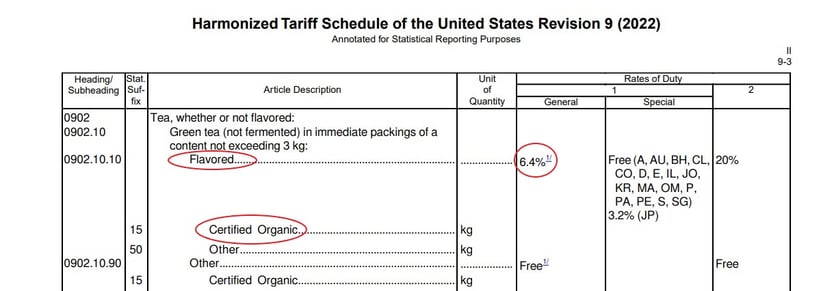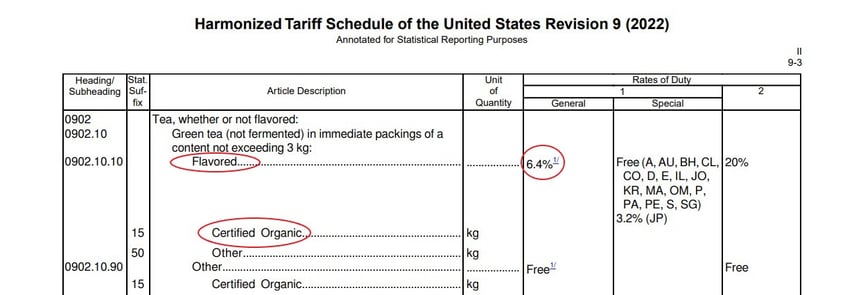Members of the World Customs Organization (WCO), which includes U.S. customs, use the Harmonized System (HS) to classify goods for customs purposes.
It provides an internationally standardized system of names and numbers that allows each country to impose and collect tariffs before products are imported into the country of destination.
Using standardized HS codes and HTS codes helps everyone simply the process of importing food products into the U.S., which you need for estimating customs duties.
What is an HS Code?
An HS code is a standardized numerical method of classifying traded products, used globally for import and export documentation and tariffs.
The Harmonized System (HS) of tariff nomenclature is divided into sections that include different internationally traded goods. For example, live animals and animal products are covered in section 1, vegetable products in section 2, and so on.
The HS Nomenclature is organized into 21 sections, 99 chapters, more than 1,000 headings, and more than 5,000 subheadings.
Information is organized in descending degree of complexity. For example, sections and chapters describe general categories of goods (such as “Live Animals; Animal Products”), while headings and subheadings provide increasing detail (such as “Live Bovine Animals” and “Cattle”).
HS codes are six digits long based on the chapter, heading, and subheading under which the imported good is found. Here’s an example using HS code 0902.10:
Reading an HS Code
- 09 – Chapter (e.g. Coffee, tea, maté, and spices)
- 0902 – Heading (e.g. Tea, whether or not flavoured)
- 0902.10 – Subheading [e.g. Green tea (not fermented) in immediate packings of a content not exceeding 3 kg]
By knowing the HS code, you can quickly identify the product being imported. Alternatively, knowing the product allows you to establish its HS code.
What is a HTS Code?
An HTS code is based on an HS code, but important information is added for additional classification.
The United States uses Harmonized Tariff Schedule (HTS) codes to classify products imported into the country. The HTS code affects customs duty rates, additional duties, and other important regulations. An HTS code is based on an HS code, but important information is added for additional classification.
So, what is the Harmonized Tariff Schedule? It is a document that establishes the tariff rates and statistical categories of all goods imported into the United States. It is based on the Harmonized System (HS) used around the world and is administered by U.S. Customs and Border Protection at U.S. ports of entry.
An HTS code can be 8-10 digits, depending on the country. The HS code makes up the first 6 digits, while the importing country assigns the remaining 2-4 digits. A U.S. HTS code is 10 digits, as we show using our example of green tea from above with HTS code 0902.10.1015:
How to Read a U.S. HTS Code:
- 09 – Chapter (e.g. Coffee, tea, maté and spices).
- 0902 – Heading (e.g. Tea, whether or not flavoured).
- 0902.10 – Subheading [e.g. Green tea (not fermented) in immediate packings of a content not exceeding 3 kg].
- 0902.10.10 – Subheading (e.g. Flavored) – establishes the U.S. customs duty rate.
- 0902.10.1015 – Subheading (e.g. Certified Organic) – provides additional statistical information.
In this U.S. HTS code example, you can see how the code simply appends information to the HS code. In this case, the code indicates that this is a flavored, certified organic green tea.

Make Sure to Use the Correct U.S. HTS Code
The HTS code determines the customs duties and fees you pay. Using the wrong code can mean you’re paying too much or too little. Either way, it’s not good for business in the long run. Also, don’t use a U.S. HTS code for products shipped to other countries since they have their own variations of HTS codes. Using the wrong code can cause a shipment to be rejected.
It’s a good idea to use a licensed customs broker to file paperwork and verify the HTS code. Sometimes importers with lack of experience tend to misuse the HTS code, which invites problems in an already challenging industry.
The Importer is Responsible for the Correct HTS Code
The supplier may be able to provide the HTS code, but understand that the importer is responsible for filing entry forms with the correct values; any problems due to using the incorrect HTS code will fall on them.
It is illegal to misclassify your goods, and doing so can lead to fines and other penalties. That’s why it’s vital to use the correct HTS codes when importing goods into the country.
The website for the U.S. International Trade Commission has an HTS code lookup. Identifying the correct code can be challenging in some instances because products can sometimes appear to fall under different descriptions; try reaching out to your customs broker if you need help. You can also request a ruling on how your product should be classified by contacting U.S. Customs and Border Protection.
Once you have the code, you can use it for estimating customs duties required upon importing the product into the United States. Let’s look at how to do that below.
How Do I Estimate Customs Duties?
We’ll continue using our example of green tea that is flavored and certified organic.

When looking at the Harmonized Tariff Schedule, we see the product is subject to a 6.4% customs duty rate (circled). The “General” sub-column sets the normal trade relations (NTR) rates applicable to all products except for those from countries with special tariff rates, as shown in the “Special” sub-column.
In our example, importing from the countries in parentheses after “Free” in the “Special” sub-column carries no customs duties. Hovering over the abbreviations on the USITC website will reveal the country, as shown below when hovering over “AU”, which is the abbreviation for Australia:

Below that, you can see the special 3.2% customs duty for the Japan Special Rate (JP).
Customs duties rates in column 2 (20% in this case) are for Cuba and North Korea.
Now, when it comes to estimating customs duties, multiple the rate by the total value of the imported goods, found on your commercial invoice. Bear in mind that this provides an estimate only and may not reflect the actual amount owed due to other special fees or duties.
We Can Help Sort Through the Confusion
The importing business is wrought with challenges, especially if you’re a beginner. Making errors on FDA entry submissions and other paperwork just adds to the hassle. If you have questions about HTS codes, or any aspect of importing products into the United States, contact our FDA regulatory experts at EAS Consulting Group (a Certified Group company) for answers.


